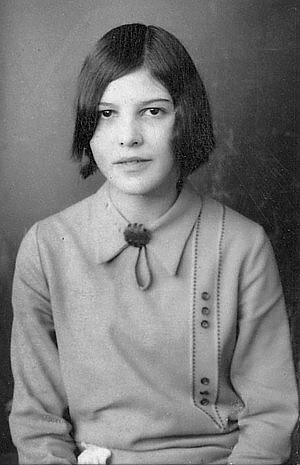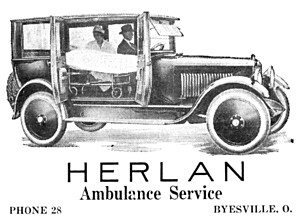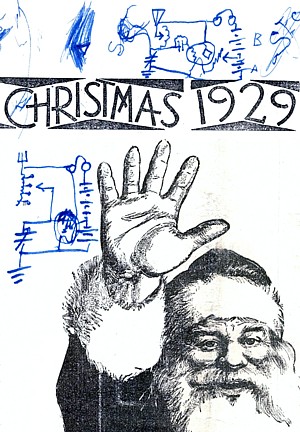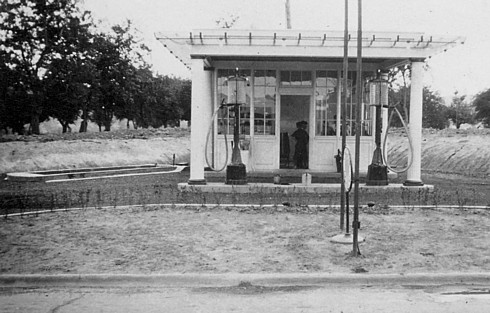Byesville
High, Part 1
Written
July 7, 2009
|
Background: To describe my mother’s high school days, I’ve decided that the best technique is that of the ghostwriter. I’ll narrate the story in the first person, as if I were her. Of course, she died in 1982, and she never actually told me much about Byesville High School. But I do have her photograph albums. More importantly, she saved 23 issues of the school newspaper, which lay in a box in my basement for ten years before I got around to reading them front to back. From these and other resources, I’ve reconstructed the surprisingly detailed “memoir” that follows. |
|
Well, Tom, as you know, before I was married my name was Ann Buckingham. I grew up on a farm in Noble County, Ohio. I was 11 years old when our family left the farm and moved to a town in Guernsey County, about 20 miles away. That would have been in 1924. The town we moved to was Byesville, where we ran the Byesville Dairy Company on Watson Avenue. We manufactured ice cream and dairy products, including pasteurized milk. I already had relatives in Byesville. One of my mother’s sisters had married into the Herlan family, and they ran a funeral home there and used one of their vehicles as an ambulance. Margaret Herlan was about my age, or maybe five years older. She went to college at Ohio Wesleyan and graduated in 1930. |
|
Byesville wasn’t a big town — the population was about 2,700 — but it was thriving. This is a little dated, but it comes from the 1911 History of Guernsey County, Ohio, by Col. Cyrus P. B. Sarchet.
In 1881 the village possessed but a little more than 300 souls, but it has grown wonderfully. Byesville is fast coming to be a factory town.
The people have given several concerns a bonus to locate in their midst, and such concerns have brought much wealth to the place. Among these may be named the tile works at Stop Nine, for which $8,000 was raised. The Byesville Glass and Lamp Company employed over 200 workmen, paying out $6,000 every two weeks for some time.
The coal mining interest is the life of Byesville today. About 20 coal mines blow their whistles daily to call the hundreds of workmen.
The paved streets and general appearance of the place indicate thrift and enterprise.
We did have a bigger city nearby: Cambridge, the county seat. It had five times the population and was only five miles away. But little old Byesville was big enough for a farm girl like me.
My last summer before starting high school, all of us got together in August and we took some pictures. In this first one, notice the three boys in the white shirts. I forget the name of the one on the left, but that’s my big brother James in the middle and my bigger brother Ralph on the right. Ralph had already graduated from high school, and he was going to work for Kresge’s dime stores up in Michigan. Oh, and that older lady in the back? That’s my grandmother Mary.
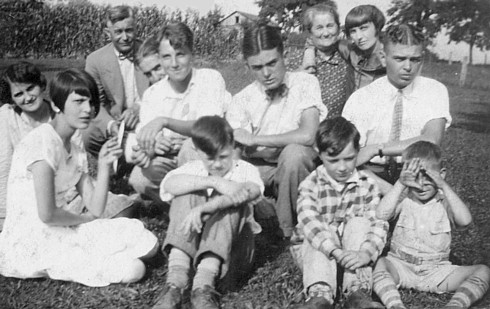
You can find another photo here. And there are two more below; I marked the first one “Sittin’ Pretty” and the other one “Standin’ in a Row.” Obvious titles, I suppose.


The next month, September of 1927, I became a freshman at Byesville High School.
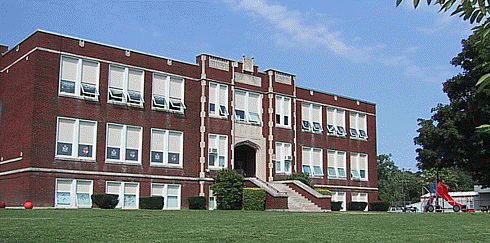
2001
PHOTO
The “House of Knowledge” was a new building, only three years old, and it had a very impressive stairway in front.
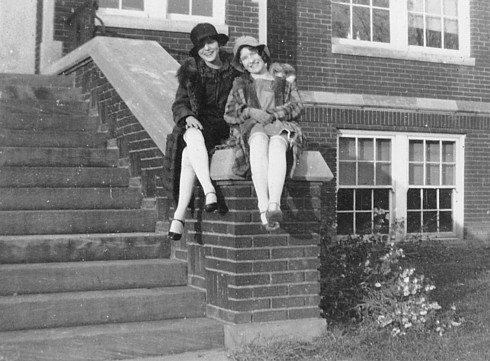
1928
PHOTO
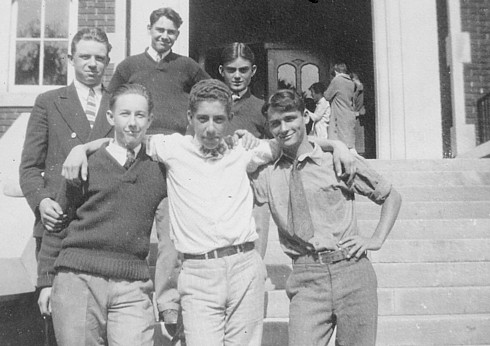
 My
brother James was a junior that year, and he was president of his
class. In the picture above, he’s standing behind some of
the other junior boys. And that’s his senior picture on
the right. Jim's class was the same size as mine, with 40
students in it.
My
brother James was a junior that year, and he was president of his
class. In the picture above, he’s standing behind some of
the other junior boys. And that’s his senior picture on
the right. Jim's class was the same size as mine, with 40
students in it.
I don't remember much that happened when I was a freshman. But the next year, they started up a school newspaper that came out twice a month. They called it The Blue and White. I still have some old issues, and maybe they will jog my memory.
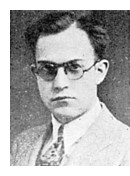 That winter, it would have been December of 1928, the big news was
that our principal, Mr. A. Clyde Scourfield, got married. The
girl he married, Thelma Gollop, was from the Class of 1925.
When the principal came back to school on the Monday after the
wedding, he tried to give a quiz to his physics students, but instead
of writing down their answers they wrote him letters of
congratulation. I guess he let that pass.
That winter, it would have been December of 1928, the big news was
that our principal, Mr. A. Clyde Scourfield, got married. The
girl he married, Thelma Gollop, was from the Class of 1925.
When the principal came back to school on the Monday after the
wedding, he tried to give a quiz to his physics students, but instead
of writing down their answers they wrote him letters of
congratulation. I guess he let that pass.
But Mr. Scourfield showed no leniency when it came to heel plates. These were little pieces of steel that some of the boys attached to the heels of their shoes. The plates made a clicking sound when the boys walked on the hard floors. The boys thought that was neat, but the principal certainly didn’t, and he’d come storming out of his office if someone walked by a-clickin’. (Didn’t you tell me, Tom, that when you were in high school 35 years later, some of the rougher sort of boys were still getting reprimanded because they had “taps” on their heels?)
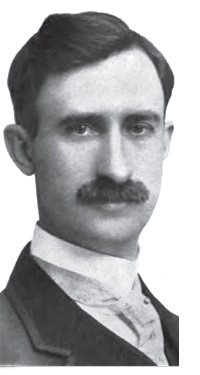 When
Governor Myers Y. Cooper (left) was inaugurated in January of
’29, they installed a radio in the school so we could all listen
in. They even talked about letting us listen to broadcasts from
the Ohio School of the Air on a regular basis.
When
Governor Myers Y. Cooper (left) was inaugurated in January of
’29, they installed a radio in the school so we could all listen
in. They even talked about letting us listen to broadcasts from
the Ohio School of the Air on a regular basis.
And then a couple of months later, Bernard Heskett got to broadcast over the radio himself, on WEBE. Bernard was the manager of the high school basketball team that year. (Just like you, Tom.)
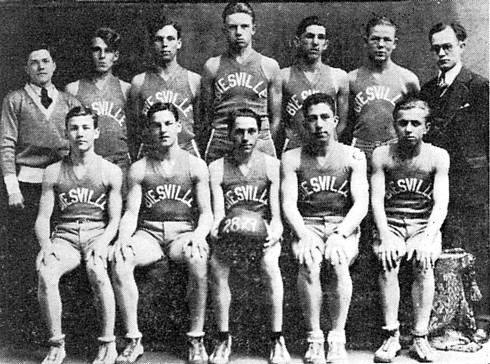
That’s Bernie on the left in the back row. Our principal Mr. Scourfield is on the right; he was also the basketball coach until they hired Coach Malcolm Garner for the next season.
Speaking of radio, it was quite a fad back then. At the Junior-Senior Banquet in April of 1929, the menu included Chicken a la Heterodyne with Microphone Potatoes, Bean Tubes, and Kilocycle Cabbage. I guess all those are radio terms. And then after dinner, the “Junior-Senior Network” put on a “radio program.” The chief announcer was Thearle Conroy.
Coca-Cola bought an ad in The Blue and White in October 1930 inviting people to listen to their weekly program on a Pittsburgh station. “Tune in on station KDKA every Wednesday. Coca-Cola Dance Orchestra. Grantland Rice interviewing sports champions. Broadcast from NBC New York Studios.” When the ad ran again in November, the band was “an all-string 31-piece dance orchestra,” and three different stations were mentioned: the Pittsburgh affiliate had changed to WCAE (which later became WTAE and then WEAE), and the other two were WSAI from Cincinnati and WTAM from Cleveland.
Several stores in town sold radio sets. You could buy a Crosley radio at Egger’s appliance store, where the phone number was 1. Jimmie Hoag sold the Orpheus-Leader. Mr. Thompson had the Stewart-Warner and also the Philco. I remember the Majestic, which came in a “low boy” table model and a “high boy” floor model that was $30 more.
These sets were expensive. In those days, you could buy a brand-new car for only $585, the price that Shaw & Larrick advertised for a 1930 Whippet four-door sedan. A new radio cost about a quarter of that, or around $150 — without the tubes, which you had to buy separately.
But radio prices did come down. By the spring of 1930, they were advertising a Majestic complete with eight tubes for only $116.50. By that fall, you could get a little Crosley for $59.50 complete — only a tenth the price of a Whippet.
|
Several students tried to build their own. Crystal sets were easy to make, but the more ambitious boys put together real single-tube radios. Somebody made these circuit drawings in the margin of my copy of the newspaper. There’s the “A” battery, the “B” battery, the headphones, the tube, the antenna, the ground, all of it. I forget who drew this, but the name Bill Secrest is doodled beside it. |
|
A lot of businesses in town sold automobiles, too. New and improved models were introduced every year. Shaw & Larrick were the dealers for Willys-Overland cars, like the Whippet Four and the Willys Six. The Bates Garage had the Hudson and the Essex. And Korte Brothers advertised Chevrolet sales and service.
Gregg & Atherton sold Fords. In their ads they downplayed the fact that they had been offering the same old Model A since 1927. At the same time, they played up the founder of the company, everybody’s hero: “Henry Ford has added two new body types to the already complete line of Model As.”
Drivers could buy Sohio gas and oil at Hoag Electric. Jack Archer had a filling station, and so did Myron Slay, who sold Cities Service gasoline at the Sunrise Park Filling Station. For posterity, I took a picture of a “fillin’ station,” with its two gasoline pumps set back from the road.
The Blue and White became an even better student newspaper when I myself wrote an article for it in March of ’29. It was called “At a Basketball Game.” You didn’t know your mother was a sports columnist when she was just a 16-year-old sophomore, did you? Here it is.
Byesville citizens are very proud of the High School basketball team, and many of them attend the games and observe them with much more ease and enjoyment than I did at the last one I attended.
This certain evening, which was a time of agony and distress, the teams came rushing out on the gym floor, each ready to defeat his opponent.
About me, on all angles, were multitudes of squealers and shriekers, who did all within their power and possession to burst my eardrums, batter my face, smash my feet and dinge my headgear.
During the second quarter, after a thrilling basket made by one of the team, a squealing, shrieking animal located somewhere near threw what seemed to be a brick, but proved to be a piece of candy, directly towards me, and sure enough it landed right on my head. Down, down, I seemed to sink. Deeper, and deeper into an ocean of water, or unoccupied space, I am unable to recall which. It is utterly impossible for me to estimate the amount of seconds or minutes that I lived in another world, but Heaven it must have been, for such is life no matter where you go after leaving such a crowd of insane animals as those usually found at a basketball game!
But the most shocking and unusual part of it — the candy was made by the Freshman Cooking class, and imagine it! After I had completely revived, I actually saw some of the people near me attempting to eat it! Good luck for the dentist! I am sure they would have plenty of employment during the following week or maybe month.
Then — could you possibly feature it. No, I didn’t get a black eye, or get entwined in some female’s chewing gum, as is a usual occurrence at such games! The terrible, unaccounted for happening was — when I got home I realized the fact that I was wearing a different hat from the one I had worn to the game. It was of red felt, with an enormous and uncouth feather extending out in front exactly twelve inches, and attached to the back were lavender streamers measuring about three feet in length.
There is usually some possible explanation for such a “mixup,” but all the explanation I have for this one is, some other dazed animal must have tossed his or her hat into the air at the same time mine began its journey to the upper regions, and on the return trip the hats switched cars and my hat went down on the wrong track.
But I am not weeping tears of regret over my loss, maybe I should say gain, for I have decided to carry the headgear which I took home with me from the last game back with me to the next one and send it on another excursion, in hopes that my own will come back to me on the return trip.
We were really proud of our basketball team, and we did get all excited and jumped up and down and screamed and everything. I think I told you, Tom, about the night we were playing in a tournament at the McMahon Gym over in Cambridge. I went to Cambridge early so I could shop. I bought a record, some song that I really liked. Back in those days, records were big black 78-rpm disks made out of shellac, and they were fragile. Well, when I got to the gym I laid my things on the floor by my seat, and of course the game got exciting and we started jumping around and cheering, and of course I forgot about the record. Sure enough, when I went to leave, it was broken. I was so disappointed.
|
The story continues in Part 2. Byesville High School wins a basketball championship, Ann wins the title of prettiest girl in school, and one of the players becomes her boyfriend! |
